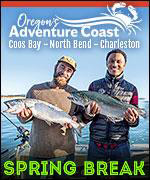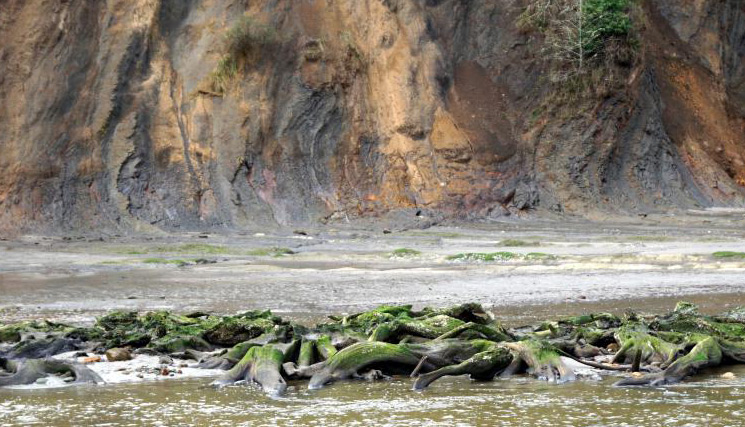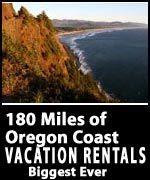The Unheralded Ghost Forests of South Oregon Coast / Coos Bay in Photos
Updated 02/24/21 at 5:06 AM PDT
By Oregon Coast Beach Connection staff
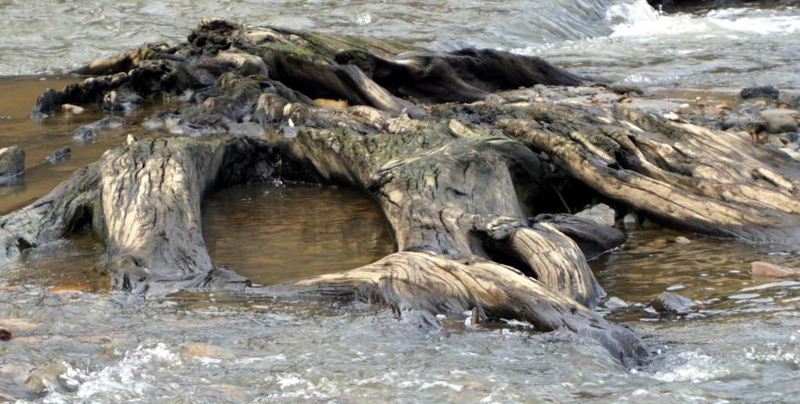
(Coos Bay, Oregon) – They're spectacular with their intricate, even eerie appearance, but they're never talked about. Certainly not as much as their ancient “cousins” farther up the Oregon coast at Neskowin, or even those around Newport. (All photos courtesy Brent Lerwill).
CoastWatch volunteer and Charleston resident Brent Lerwill was kind enough to send these photos along, showing a mesmerizing structure and a sort of Gothic look.
Includes exclusive listings; some specials in winter
In Cannon Beach:
Includes rentals not listed anywhere else
In Manzanita, Wheeler, Rockaway Beach:
Some specials for winter
In Pacific City, Oceanside:
Some specials for winter
In Lincoln City:
Some specials for winter
In Depoe Bay, Gleneden Beach:
Some specials for winter
In Newport:
Look for some specials
In Waldport
Some specials for winter
In Yachats, Florence
Some specials for winter
Southern Oregon Coast Hotels / Lodgings
Reedsport to Brookings, places to stay; winter deals
The ghost forests at Sunset Bay at Coos Bay are perhaps among the most interesting-looking of all the ancient stumps around the coastline of Oregon, and it turns out they're much younger than many found on this shoreline at around 1200 years old. .
Their origins are still the subject of some debate, but one thing is for sure: they're one of the unusual cases of Oregon coast ghost forests in that they are visible year-round. Sunset Bay's little additions to this rather trippy subsection of geology stayed hidden much of the time for decades, only appearing during winter when sand levels dropped enough. Just like those other places on the northern half, such as Newport or just south of Cannon Beach, you only saw them after lots of storm action. Then, about 10 or 15 years ago they began to be visible throughout the entire year. It just took low tides to bring them into view.
You can see clear evidence of that kind of existence. Lerwill's photos show them with varying degrees of barnacles and other sea life growth covering them. That's a sure sign they've been out of the sand for a long time, just like Neskowin's year-round ghost forest has stumps that are pretty well-colonized.
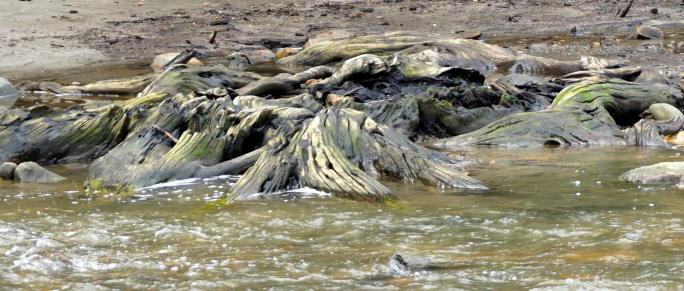
How these stands of trees became ghost forests is rather murky. The generally-accepted origin story here is that it was a quake around the year 800 that dropped the rocky platform of the bay and swallowed the trees. The problem with that is it just seems to be repeated without an actual researcher being quoted. Some carbon-dating has been done on these and they are from about that time, but the quake theory seems rather loose.
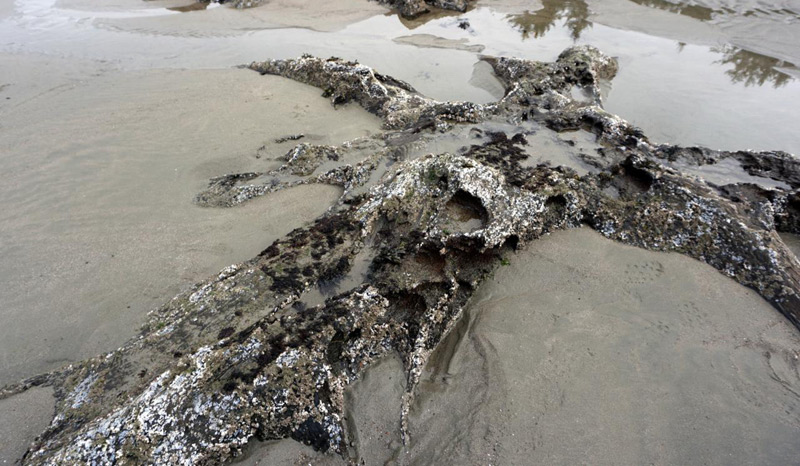
For a long time, until the late ‘90s or so, it was believed ghost forests along the Oregon coast were the product of some sort of massive quake that dropped the earth suddenly, then covered the forests with sand and such. In fact, most of the public still believe that though it's been disproven. Almost all media and blogs out there have run wild with that idea, because as one geologist put it: a quake is “a lot sexier” than the slow, gradual smothering by sand that has largely been proven. See Explanations of Neskowin Ghost Forest Wrong, Say Oregon Coast Geologists
This is called encroachment, and it comes from the 2006 paper by geologists Roger Hart and Curt Peterson that's considered the expert word on the subject. Basically, all beach ghost forests that have been documented were, so far, a slow process of inundation.
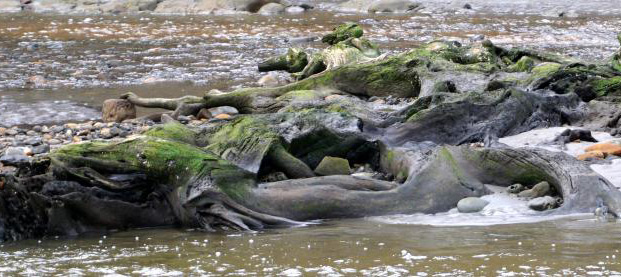
While Coos Bay's Sunset Bay encroachment idea doesn’t appear to be 100 percent for certain, there is an earlier geology paper that helps back that up. Currently, there doesn't seem to be any serious evidence that quakes buried them, however.
It turns out the ghost forests here had been carbon-dated sometime before 1980, though who did it is not known by many. Geologist John Armentrout conducted that work but it wasn’t officially published until 1980 in a book featuring different authors called “Geologic Field Trips in Western Oregon and Southwestern Washington.” In the book, he says he found them to be 1200 years old – from about the year 800. This helps explain the year mysteriously quoted by state park rangers and other geology authors.
However, Armentrout didn’t indicate earthquakes as a cause for the ghost forest stumps. He too favored a slower demise.
“The trees could have been growing on the Holocene flood plain of Big Creek and drowned as the sea carved out the Sunset Bay amphitheater long after sea level attained its present position,” he wrote.
Peterson, a retired geology professor from Portland State University, showed Oregon Coast Beach Connection other documents and shared some insights into his own landmark paper.
He added that since some fault lines and other features connect to this area, there's a lot going on in the geologic record but there's no solid evidence there really was a subsidence [sudden drop] event here in 800. At least not that year.
“Unlike the northern Oregon estuary core sites, most of the core sites in Coos Bay, including Sunset Bay marsh, do not show simple coseismic subsidence cycles,” Peterson said.
He and Hart found evidence of several little quake events and possibly two large and abrupt shakers. Yet when Hart and Peterson dug around Sunset Bay and the ghost forest sites above it (Big Creek) one big thing did not show up, and that casts more doubt that the ghost forests here were submerged by a quake.
“However, both core sites lack clear evidence of tsunami inundation in association with the apparent abrupt subsidence events,” Peterson said. “Several test core sites at the Sunset Bay shoreline showed that the submerged stumps there (in the modern beach) occurred in context with wetland peats, indicating that the Sunset marsh extended to the present Sunset Bay shoreline (south side) in prehistoric time.”
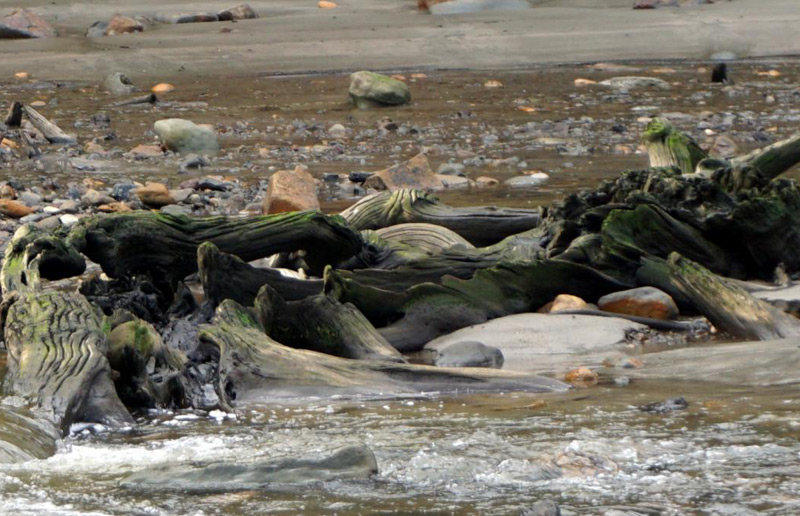
In essence, it's not completely clear what drowned this forest, but it seems to have been a slow process – and there’s sizable evidence against it being a sudden drop. Conversely, Peterson said it's not like other ghost forest sites on Oregon beaches, either.
Hart and Peterson didn't carbon-date those ghost forests like they did those on the central and north coast. They did some carbon-dating on a set of trees hanging out from a sea cliff somewhere in the area and found them to be nearly 7,000 years old.
That leaves Coos Bay with almost the oldest known ghost stumps in Oregon (the oldest are at Netarts at around 80,000 years, according to Peterson)..
Whatever the case, the Coos Bay / Charleston area leaves us with a delicious little mystery and some freakishly cool stumps.
South Coast Hotels - Southern Coast Travel, Maps
Cannon Beach Lodging
Nehalem Bay Lodgings
Manzanita Hotels, Lodging
Three Capes Lodging
Pacific City Hotels, Lodging
Lincoln City Lodging
Depoe Bay Lodging
Newport Lodging
Waldport Lodging
Yachats Lodging
Oregon Coast Vacation Rentals
Oregon Coast Lodging Specials
More About Oregon Coast hotels, lodging.....
More About Oregon Coast Restaurants, Dining.....
LATEST Related Oregon Coast Articles
Saturday, Dec. 27 through Wednesday, Dec. 31 from Brookings to Warrenton. Brookings events, Gold Beach events, Port Orford events, Coos Bay events, Bandon events, Florence events, Yachats events, Newport events, Lincoln City events, Rockaway Beach events, Manzanita events, Cannon Beach events, Seaside events, Astoria events
Latest on Oregon Coast Humpback Whale: Rescue Fails, Euthanized
Officials: stay away from this site in north Yachats. Marine sciences
This Week's Storms Could Reveal Oregon Coast Oddities: More Ghost Forests, 'R...
A geologic freak zone may open up - but maybe agates, too
License Plates for Oregon Coast's Largest Aquarium Coming Soon - Mural Artist...
Tufted Puffin plates in production, aquarium calls for artists. Newport
Oregon's Tillamook Coast Features Halloween Train, Ghost Story Walk, Corn Maze
All month: Kilchis Maze. Oct 26 - 26: Halloween Train, Halloween Town Rockaway Beach. Tillamook events, Rockaway Beach events
Latest on Shellfish Fun Along Oregon Coast - Pacific Halibut Angling
Crabbing, mussels, razor clams and ocean fishing. Marine sciences
Back to Oregon Coast
Contact Advertise on BeachConnection.net
All Content, unless otherwise attributed, copyright BeachConnection.net Unauthorized use or publication is not permitted














